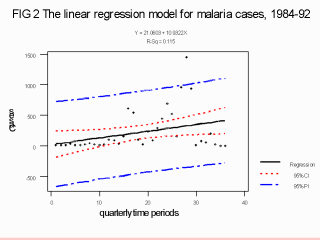| front |1 |2 |3 |4 |5 |6 |7 |8 |9 |10 |11 |12 |13 |14 |15 |16 |17 |18 |19 |20 |21 |22 |23 |24 |25 |26 |27 |28 |29 |30 |review |
 |
CI denotes confidence interval PI denotes prediction interval Noticeably, the spikes of malaria are observed in the periods 16,17,24, 28 & 29 (Figure 1 & 3). A remarkably sharp increase in malaria cases is observed in the period 28 (That is, 4th quarter of 1990). Interpretation of the regression model: Holding other things constant, in the sampled periods 1984-92, 1 unit increases in time, the malaria case on the average increases by about 11. With respect to adjusted R-Sq, the explanatory power of the model is 8.9%. [Note: Not a good model!. But, it is useful for an exercise.] Of note, the simple, or two-variable regression model using time as an independent variable is limited in information. Regarding the two-variable regression model, it would be more information, if we can use an independent variable other than time. For instance, an association between the malaria cases and the rainfall in the respective months. |